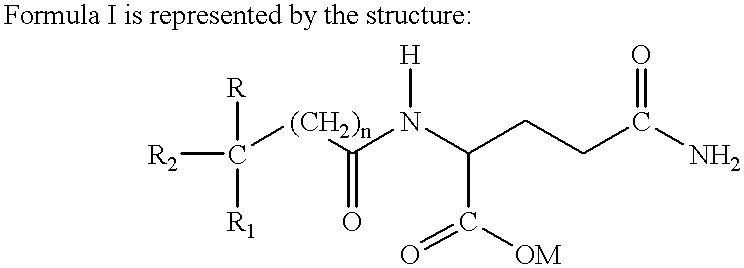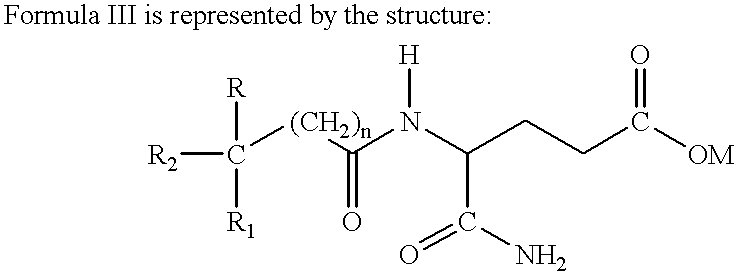Treatment regimen for administration of phenylacetylglutamine, phenylacetylisoglutamine, and/or phenylacetate
a treatment regimen and technology of phenylacetate, applied in the field of neoplastic disease treatment, can solve the problems of reducing the dose, affecting the synthesis of phenylamino-2,6-piperidinedione, and poor soluble water soluble 3-phenylamino-2,6-piperidinedion
- Summary
- Abstract
- Description
- Claims
- Application Information
AI Technical Summary
Benefits of technology
Problems solved by technology
Method used
Image
Examples
example 1
[0081]Forty-three patients diagnosed with primary malignant brain tumors were treated with daily intravenous administration of antineoplaston A10 at an average dosage of 7.9 g / kg / day and antineoplaston AS2-1 at an average dosage of 0.39 g / kg / day. Of the 43 patients, 36 were evaluable, and 16 achieved complete or partial responses by the completion of therapy without serious side effects.
[0082]Of the forty-three patients, all but one were diagnosed with histologically confirmed primary brain tumors. The remaining patient suffered from a primary brain tumor in the brain stem where biopsy could not be performed with adequate safety. Fourteen patients were diagnosed with glioblastoma multiforme and six patients were diagnosed with anaplastic astrocytoma.
[0083]Patients ranged in age from 2 to 71. Patients were selected for Karnofsky Performance Status of 40 to 100, life expectancy over two months, and age over 1 year. Patients with liver failure, hypertension not adequately controlled, o...
example 2
[0093]A Phase II clinical study of antineoplaston A10 and AS2-1 was conducted in twelve patients with high grade glioma. Seven patients were diagnosed with glioblastoma multiforme, four patients were diagnosed with anaplastic astrocytoma, and one patient was diagnosed with brain stem glioma with multiple metastases.
[0094]Patients received continuous infusions of antineoplaston A10 and AS2-1 for from 41 days to 713 days. Dosage levels of antineoplaston A10 were from 0.9 g / kg / day to 1.7 g / kg / day, and dosage levels of AS2-1 were from 0.2 g / kg / day to 0.8 g / kg / day.
[0095]Adverse drug experiences of mild nature and sporadic occurrence were noted in five patients in the trial. Two patients exhibited a mild, temporary decrease in white blood cell count and one patient exhibited a temporary decrease in red blood cell count and hemoglobin. Two patients had hypokalemia and hypoglycemia, one patient had increased fluid retention, and one patient had stomach cramps and nausea once during treatmen...
example 3
[0097]A Phase II study of antineoplaston A10 and AS2-1 was conducted on 11 patients with brain tumors. Dosage levels of antineoplaston A10 were from 3.9 g / kg / day to 12.9 g / kg / day, and dosage levels of AS2-1 were from 0.20 g / kg / day to 0.40 g / kg / day. Eight patients were evaluable. Partial response was observed for five patients by the completion of treatment.
[0098]Patients suffered from brain tumors. Injections of antineoplaston A10 and AS2-1 were administered 6×daily at 250 mL / h using a subclavian catheter and double channel infusion pump as described in Example 1. The duration of treatment ranged from 44 days to 480 days, with a median duration of treatment of 195 days. Dosage levels of antineoplaston A10 were from 3.9 g / kg / day to 12.9 g / kg / day with an average dosage of 7.2 g / kg / day. Dosage levels of AS2-1 were from 0.20 g / kg / day to 0.40 g / kg / day, with an average dosage of 0.29 g / kg / day. The maximum total dose of antineoplaston A10 was 381.738 kg and the maximum total dose of AS2-1 ...
PUM
| Property | Measurement | Unit |
|---|---|---|
| Concentration | aaaaa | aaaaa |
| Density | aaaaa | aaaaa |
| Density | aaaaa | aaaaa |
Abstract
Description
Claims
Application Information
 Login to View More
Login to View More - R&D
- Intellectual Property
- Life Sciences
- Materials
- Tech Scout
- Unparalleled Data Quality
- Higher Quality Content
- 60% Fewer Hallucinations
Browse by: Latest US Patents, China's latest patents, Technical Efficacy Thesaurus, Application Domain, Technology Topic, Popular Technical Reports.
© 2025 PatSnap. All rights reserved.Legal|Privacy policy|Modern Slavery Act Transparency Statement|Sitemap|About US| Contact US: help@patsnap.com



